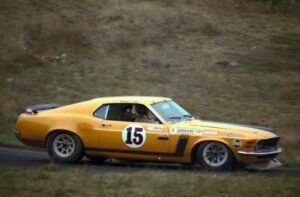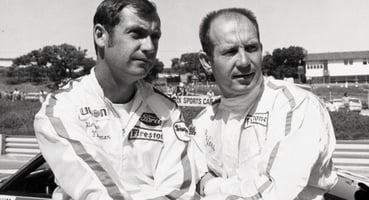Rumbling excitement billows from the stands as the crowd rises from their seats. In mere moments, the green flag will drop. The intoxicating smell of racing fuel floods the air as the roar of the V8 engines drowns out the cheers. At the starting line future legendary American muscle cars like the Plymouth Barracuda, Chevrolet Camaro, Dodge Challenger, AMC Javelin and the Ford Boss 302 Mustang are all anxiously awaiting the chance to prove their superiority. Of course, a race to prove who is the ultimate automobile manufacturer isn’t complete without a mix of European competitors that include Porsches, SAABs, Alfa Romeo, and BMWs. The sight is truly unforgettable and one that hasn’t been replicated in decades.
Before the 1973 Oil Crisis and rising insurance rates brought the Golden Age of pony cars to a slow trot, the “Golden Era” of the Trans-Am National Races ruled the track during 1968-1972. Fueled by the marketing adage “Race on Sunday, Sell on Monday”, racing spectators witnessed versions of production cars that could be bought in showroom put to the ultimate test.
The Trans-American Sedan Championship was created by the emergence of high-powered muscle cars flooding the streets. Neighbors would eye each other’s rides and wondered who’s would reign supreme – the Camaro, Challenger or Mustang. Eager to floor the gas pedal and let the horses go into full gallop required an even and… legal playing field. Hence, began one the greatest tests of automotive power.
Unlike other motorsport competitions, the original format of Trans-Am racing awarded points to manufacturers instead of the drivers. This bred the creation of some of the greatest American muscle cars of all time.
When Mustang first entered the race scene, Ford tasked Carroll Shelby to design a fierce competitor for the track. The resulting GT350R held the B-Class Sports Car Club of America (SCCA) title and got manufacturers to pay attention to the race-potential the Mustang had. By 1969, at the height of the Trans-Am “Golden Era”, Shelby decided to take a break from designing cars. This left Ford on the hunt for a replacement.
The true beauty and the crux of SCCA rules stated that to compete in the Trans-Am races, manufacturers had to have a production model of the car available in the showroom. Ford needed to create a new race-ready model and calculated brilliantly by hiring Larry Shinoda.
Shinoda was a perfect fit for Ford. He had a history as a hot-rodder which meant he understood the marriage of performance and design. Plus, he was recruited from GM which made him intimately familiar with the Camaro Z28; Mustang’s top competitor on and off the track. With Camaros dominating SCCA Trans Am racing in previous years, Shinoda’s sole purpose was to design a car that would outrun the competition – The Boss 302.
Unleashed onto the track in 1969, the Boss 302 wouldn’t lead Ford to victory until the following year. Piloted by legendary driver Parnelli Jones, Mustang would reclaim the SCCA Trans Am Championship from Chevrolet a year later. It’s been 52 years since the jaw-dropping finish between teammates Parnelli Jones and George Follmer at the Mission Bell 200, in Riverside, California on October 4, 1970.
Leading up to the final match up in California, Ford stayed ahead in points after every round despite the obstacles that occurred along the way. The tone at the start of the 1970 racing season in Laguna Seca was rough. Crews were having a hard time passing tech inspection and Ford was not immune. The SCCA had brought on a new technical inspector who found numerous infractions including Follmer’s number 15 car. Even after passing, both Boss 302s hit another obstacle when SCCA officials promptly outlawed the new In-Line carburetors stating they violated the “spirit of the law” in keeping the cost of the Trans-Am racing to a minimum.
Yet, despite these hiccups Saturday’s qualifying confirmed to all that the Boss 302s were the fastest cars on the track. Jones qualified his number 15 on the pole and Follmer’s number 16 came in third. Throughout the whole race, Mustang held the advantage over the other teams. The Boss 302s were basically the same cars as the previous year while every other team was sorting out new body styles, teams and even cars.
As soon as the green flag dropped, Jones immediately grabbed the lead and two-thirds of the way he had lapped everyone except for Team Penske’s Javelin. With it trailing nearly 40 seconds behind, Jones slowed down to allow Follmer to catch up. The two bright orange and black racing striped Boss 302s crossed the finish line together, signaling to all in attendance that Ford was here to win the championship.
The second round in Dallas was rained out and cancelled. During the third round in Connecticut, Follmer’s engine blew but Jones claimed victory over Camaro despite fading brakes, a lost engine valve and an exhaust pipe that fell to the track with three laps to go. At the fourth round in New Hampshire, Follmer claimed victory three laps over Javelin while Jones had to exit early despite being in second place. The hood on his Boss 302 had flown off yanking the hood pins out of the subframe and the hinges out of the firewall.
Rivalry between the two teammates became abundantly clear during the fifth round in Ohio. Ford’s objective was to have either Mustang take the win over Chevrolet. They didn’t care which driver claimed victory as long as it had Ford on it. Follmer though was determined to cross the finish line before Jones. Ignoring the pit crew’s signs to slow down, Follmer risked potentially losing both cars. Despite Follmer’s best efforts, Jones, the more seasoned driver took the win.
The sixth round in New York had Jones declaring to the press, “They don’t want Ford to win this series!” The SCCA had outlawed the headlight opening brake ducts as well as the Auto-lite In-Line induction. Jones’ realization came to fruition when during the race, SCCA officials black-flagged Folmer for a mix up in the pit that they refused to back down from. Neither teammate claimed victory for the first time in the season.
Despite suffering another loss again in the seventh round in Minnesota, this time to Chevrolet, Ford stayed at the top of the leaderboard. The eighth race gave Javelin the win and allowed American Motors a substantial gain in points, inching closer to Ford. Jones had finished in fifth place and Follmer dropped out due to suspension problems. Round nine became a Javelin-Mustang showdown that Ford was unable to win. Follmer finished second after losing time to have a crumbled fender removed and Jones finished third after losing a lap from spinning off course.
Unfortunately, in tenth round the Boss 302s couldn’t overcome Camaro or Javelin, leaving Ford in the lead with only eleven points separating them from Roger Penske’s Javelin. After five loses, round eleven in Washington proved victorious for Jones and left no doubt that the Boss 302 was the best Trans-Am race car in 1970.
The final round of the season in California had every manufacture gunning to beat Ford. The track was in the backyard of the automotive press and a win over the “champion” Mustangs would help with sponsorship bargaining for the ’71 season.
Even before the race began, the Boss 302s were the top three fastest cars at Riverside with Jones qualifying first and second and Follmer qualifying third. The other manufacturers were looking for a win over Ford but, the reality was the championship race was ultimately between teammates. Follmer revealed the pure dominance of the Boss 302 by immediately driving away from the rest of the pack.
Jones however ended up in tenth place after being bumped off-course by a lap marker and returned to the fray with the right side of the Mustang crushed in, fenders rubbing the tires and the driveshaft bent. He continued until he was black-flagged for smoke. While Jones pitted for emergency repairs to the leaking transmission seal caused by the wobbling driveshaft, Foller opened a huge lead and was headed for victory.
Incredibly determined, Jones pushed his battered Mustang to the limit edging it first into third place and then overcoming the Javelin to take second. At this point in the race no other team mattered. It was a fierce showdown of pride between teammates. With his Boss 302 battered, dirty and in rough shape, Jones forced it to its limits. Meanwhile in the pits, Ford brass worried that the outcome would be two battered cars and a great loss. In a twist of sheer luck, Follmer’s shift linkage broke, leaving him without third gear which allowed Jones to take the lead and claim victory. This solidified the Boss 302 as the ultimate 1970 Trans Am Champion with Ford taking first and second place.
Finding a quality 1969 or 1970 Boss 302 survivor in today’s market has posed challenging to collectors and enthusiasts. If you are ready to own a piece of Mustang history, in our Detroit showroom, a 1970 Ford Mustang Boss 302 race car is patiently awaiting a to relive checkered glory. This G-Code Boss 302 fastback has been rebuilt to live out the rest of its years as a 1970’s style Trans-Am race car. It’s been meticulously dressed head to toe to resemble the glory years when the Boss 302 dominated the Trans Am Nationals.
Refurbished for use in open track, SVRA or SCCA environments, this race ready Boss 302’s last dyno produced 473 horsepower at 7,300 rpm and 370lb-ft of torque at 6,300 rpm. Power is provided by a replacement G-code 302 CID V8, which is paired with a top-loader 4-Speed manual transmission and a Detroit Locker differential. Notable features include titanium intake and exhaust valves, thermally coated JE Pistons, internally balanced with Crower Billet connecting rods, T&D Machine Products valvetrain, 11.5:1 compression ratio, Bud Moore Mini-Plenum intake manifold, custom-built carburetor, Ernie Elliot NASCAR-style valve covers, Ford Motorsport electronic tach-drive distributor and Performance Rod & Custom aluminum radiator w/electric cooling fan.
If you would like to learn more about the 1970 Ford Mustang Boss 302 Race Car, please contact our team in the Detroit Showroom.
Gateway Classic Cars sells and consigns hundreds of vehicles each month. Do you have a classic car for sale with a story to tell? We’d love to hear about it, please email us at news@gatewayclassiccars.com to share it.



Comments